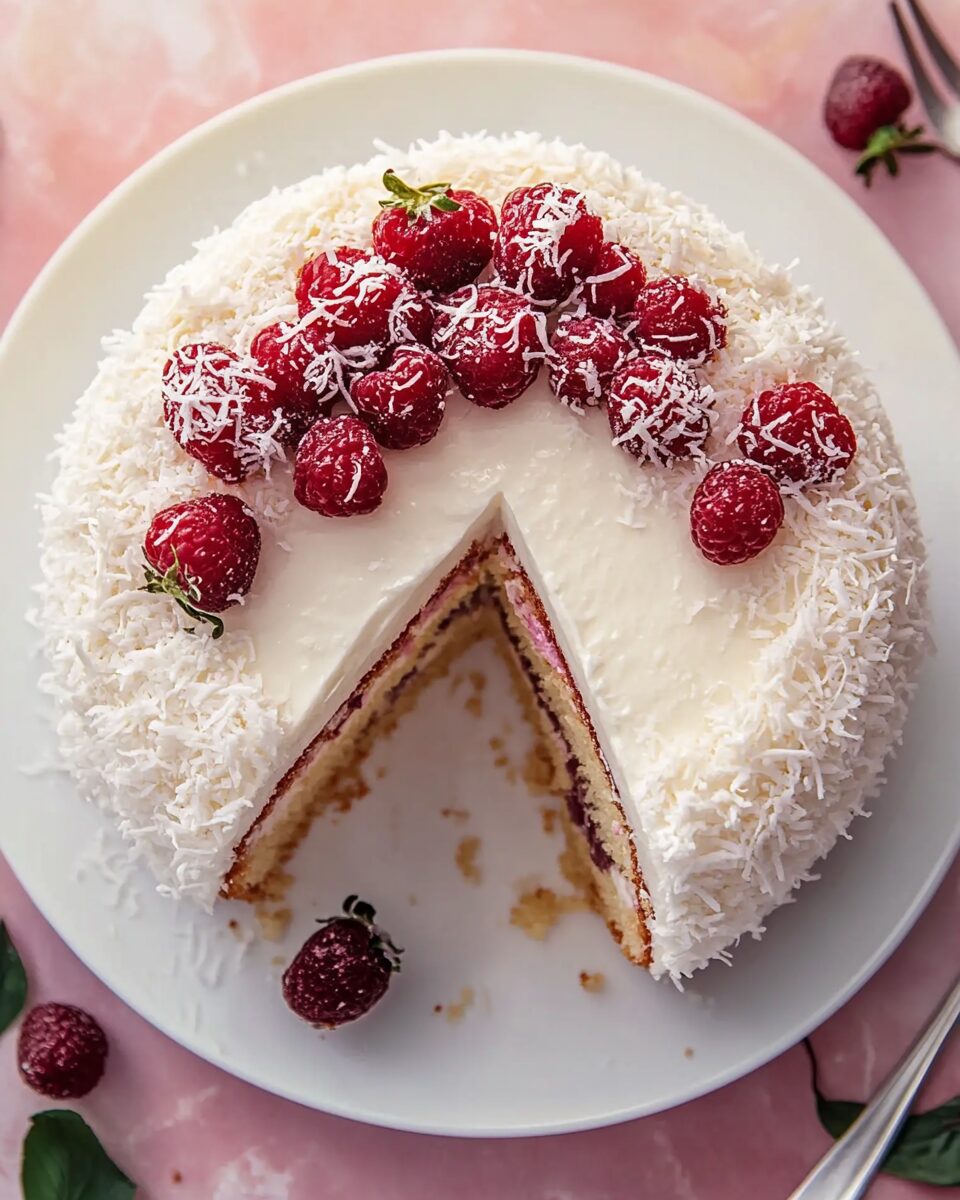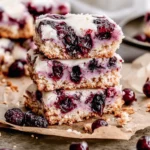A tropical treat that brings together the rich flavor of coconut and the light, fluffy texture of a perfectly baked cake. This Coconut Delight Cake is ideal for special occasions or whenever you want to indulge in something sweet and comforting.
FULL RECIPE
Ingredients
- 2 ½ cups all-purpose flour
- 1 tablespoon baking powder
- ½ teaspoon salt
- 1 cup unsalted butter, softened
- 1 ¾ cups granulated sugar
- 4 large eggs
- 1 teaspoon vanilla extract
- 1 teaspoon coconut extract
- 1 cup canned coconut milk
- 1 cup sweetened shredded coconut
1.For the Frosting
- ½ cup unsalted butter, softened
- 8 oz cream cheese, softened
- 3 ½ cups powdered sugar
- 1 teaspoon coconut extract
- 2 tablespoons coconut milk
- 1 ½ cups sweetened shredded coconut (for garnish)
Directions
- Preheat oven to 350°F (175°C). Grease and flour two 9-inch round cake pans.
- In a medium bowl, whisk together flour, baking powder, and salt.
- In a large bowl, beat the butter and sugar until light and fluffy.
- Add eggs one at a time, mixing well after each addition. Stir in vanilla and coconut extracts.
- Gradually add the dry ingredients, alternating with coconut milk, beginning and ending with the dry mixture. Mix until just combined.
- Fold in shredded coconut.
- Divide batter evenly between prepared pans. Smooth the tops.
- Bake for 28–32 minutes, or until a toothpick inserted in the center comes out clean.
- Let cakes cool in pans for 10 minutes, then transfer to wire racks to cool completely.
- For the frosting, beat butter and cream cheese until smooth and creamy.
- Add powdered sugar gradually, then mix in coconut extract and coconut milk until desired consistency is reached.
- Spread frosting between cake layers, on the top, and sides.
- Press shredded coconut onto the frosting to garnish.
Nutritional Information
- Calories: 520
- Total Fat: 28g
- Saturated Fat: 20g
- Cholesterol: 90mg
- Sodium: 220mg
- Total Carbohydrates: 63g
- Sugars: 46g
- Protein: 5g
History of Coconut Cakes
Coconut cakes have a long and rich history, tracing their roots back to Southern American baking traditions. Often served during holidays and family gatherings, the coconut cake became a symbol of celebration and indulgence. The use of coconut, once a luxury ingredient due to its importation, gave these cakes an exotic flair that made them highly sought-after in the past.
The Role of Coconut in Baking
Coconut is a versatile ingredient in baking, bringing both texture and flavor. It can be used in several forms such as shredded, flaked, or as milk and extract. In the Coconut Delight Cake, its presence in both the batter and the frosting elevates the dessert’s tropical theme and offers a balanced richness that complements the sweetness.
Texture and Moisture Balance
One of the standout qualities of this cake is its moist and fluffy texture. The inclusion of coconut milk not only enhances the flavor but also ensures the cake stays tender and soft. The shredded coconut contributes a slight chewiness that contrasts beautifully with the light crumb of the cake.
Flavor Profile
The Coconut Delight Cake boasts a delicate yet indulgent flavor. The pairing of vanilla and coconut extract brings out a warm, aromatic sweetness. The cream cheese frosting adds a subtle tang, balancing the overall sweetness and creating a more complex taste experience.
Frosting Choices and Variations
While the traditional recipe uses a cream cheese and butter frosting, some bakers may choose to substitute with whipped cream or a coconut buttercream for a lighter texture. Each frosting variation offers a different mouthfeel and can be tailored to suit personal taste preferences or dietary needs.
Decorative Appeal
This cake is not only delicious but also visually striking. The exterior coating of sweetened shredded coconut gives the cake a snowy, festive appearance that makes it perfect for celebratory occasions. It can be easily decorated with coconut flakes, fruit slices, or edible flowers for extra flair.
Occasions Best Suited For
The Coconut Delight Cake is ideal for birthdays, weddings, spring and summer gatherings, and holidays like Easter or Mother’s Day. Its light yet indulgent nature makes it a great choice for events where a refreshing dessert is appreciated.
Serving Suggestions
To fully enjoy this cake, it’s best served slightly chilled or at room temperature. Pairing it with a light tea, tropical cocktail, or coffee enhances its flavors. It can also be accompanied by a scoop of vanilla or coconut ice cream for a decadent dessert plate.
Storage and Shelf Life
This cake stores well in the refrigerator for up to five days when kept in an airtight container. The moisture from the coconut milk and frosting helps maintain its texture, and it often tastes even better the next day as the flavors continue to meld.
Make-Ahead Tips
Bakers looking to save time can bake the cake layers in advance and freeze them. Frosting can be made a day or two ahead and refrigerated. Assembling the cake the day before serving allows the flavors to settle and can reduce preparation stress for big events.
Substitutions and Adaptations
For those with dietary restrictions, several substitutions can be made. Gluten-free flour can replace traditional flour, and vegan butter and cream cheese can be used in the frosting. Unsweetened coconut may also be substituted for a lower sugar content.
Allergy Considerations
Since this cake contains coconut, dairy, eggs, and wheat, it may not be suitable for individuals with allergies to any of these ingredients. However, with some careful substitutions, it can be adapted to accommodate certain dietary needs.
Nutritional Insights
While indulgent, the Coconut Delight Cake provides energy-rich ingredients like coconut milk and eggs. The cake is high in saturated fat and sugars, so it is best enjoyed in moderation as a special treat within a balanced diet.
Popular Pairings
This cake pairs beautifully with other tropical flavors such as pineapple, mango, and lime. For a more decadent combination, a chocolate drizzle or ganache layer can create a rich fusion of flavors that enhances the coconut.
Texture Modifications
Bakers who prefer a smoother texture can finely shred the coconut or toast it for a slightly crunchy texture. Toasting coconut also deepens its flavor and adds a lovely golden hue, creating a more dynamic cake experience.
Cultural Significance
In many tropical regions and island cultures, coconut is a staple ingredient. Cakes like this one draw inspiration from those traditions and are a wonderful way to bring a bit of island flair to Western-style baking.
Children-Friendly Adaptations
This recipe is generally well-liked by children due to its sweet flavor and fluffy texture. For kid-friendly versions, you can use a lighter frosting, reduce the sugar slightly, or shape it into cupcakes for easier serving.
Baking Tips for Success
To achieve the perfect Coconut Delight Cake, ensure all ingredients are at room temperature before mixing. Don’t overmix the batter to avoid a dense cake. Let the cakes cool fully before frosting to prevent melting and separation.
Flavor Infusion Ideas
For a twist, infuse the cake with a citrus zest such as lime or orange. Adding a layer of fruit preserves or curd between the cake layers also enhances the tropical flavor and gives the cake a more sophisticated profile.
Conclusion
The Coconut Delight Cake is more than just a dessert—it’s a celebration of flavor, texture, and tradition. Its rich coconut taste, moist crumb, and creamy frosting make it a favorite for all ages and occasions. With the ability to adapt to various preferences and dietary needs, this cake is a versatile choice that will leave a lasting impression on anyone who takes a bite. Whether enjoyed at a family gathering or a formal event, it brings a sense of comfort and elegance to the table.






